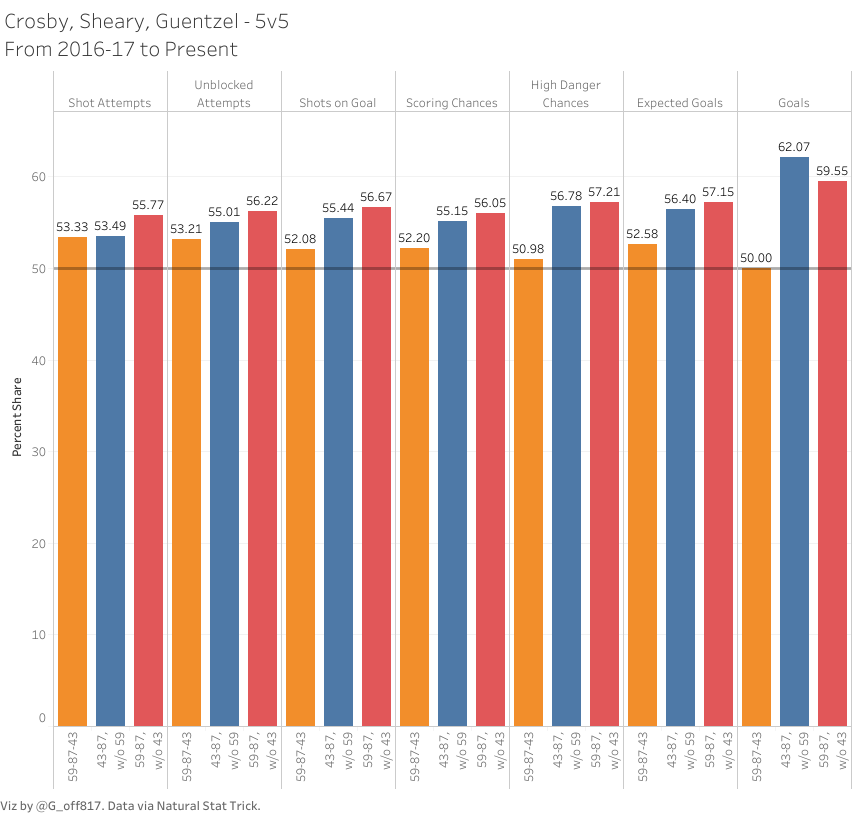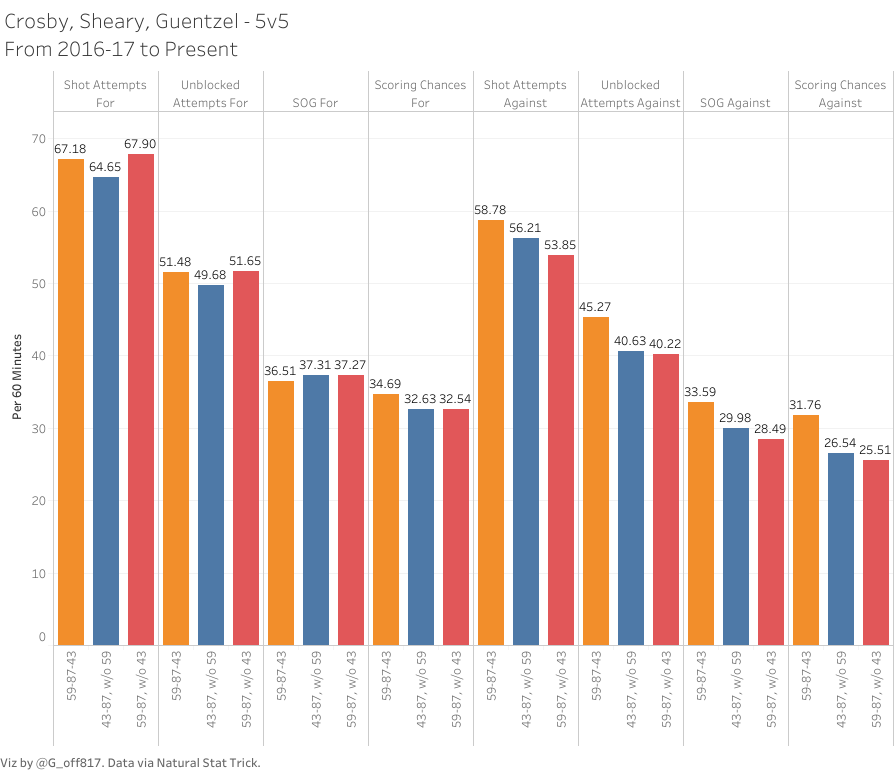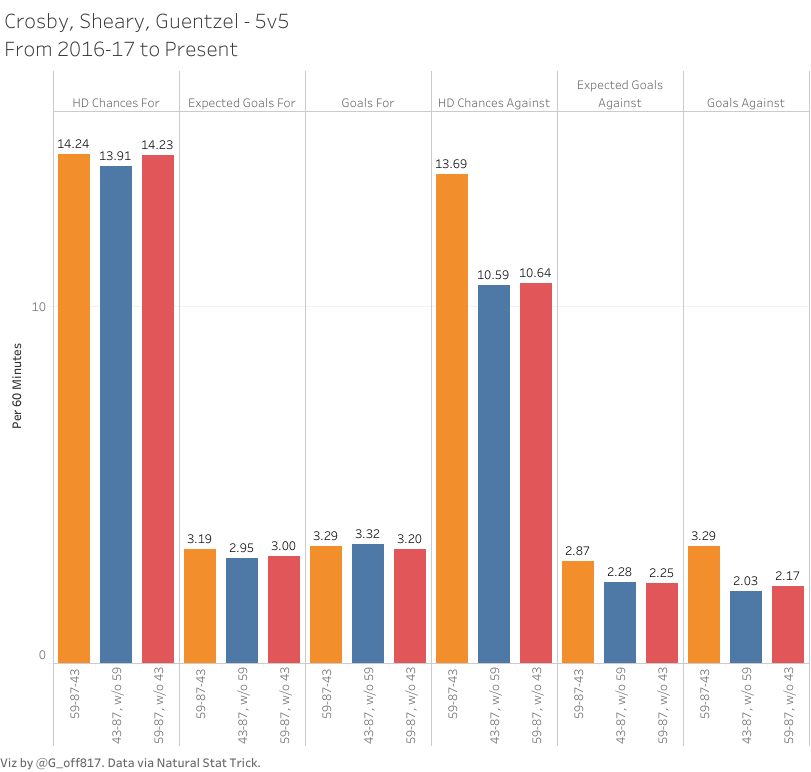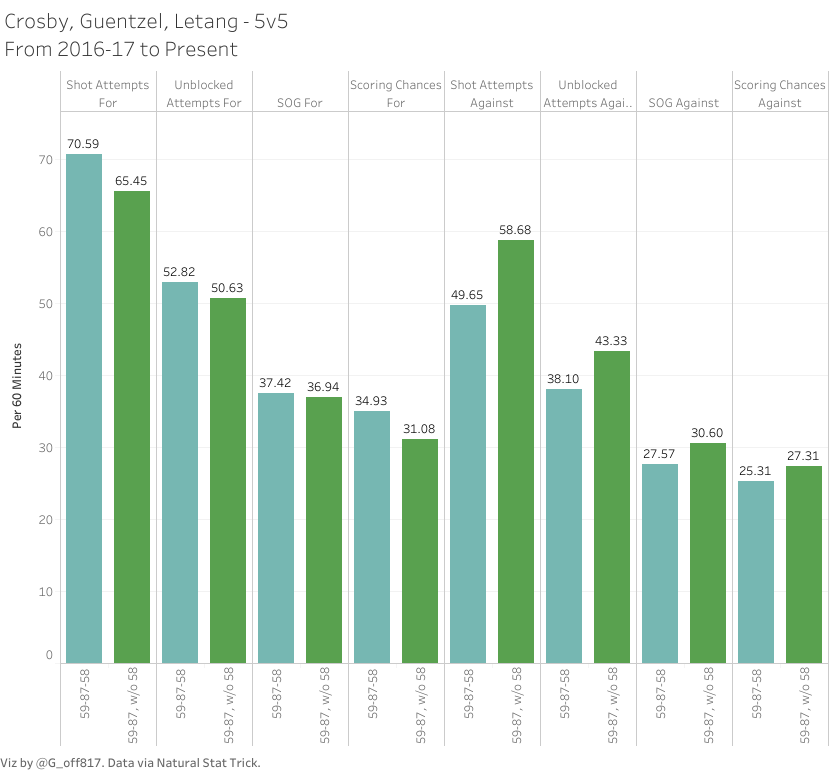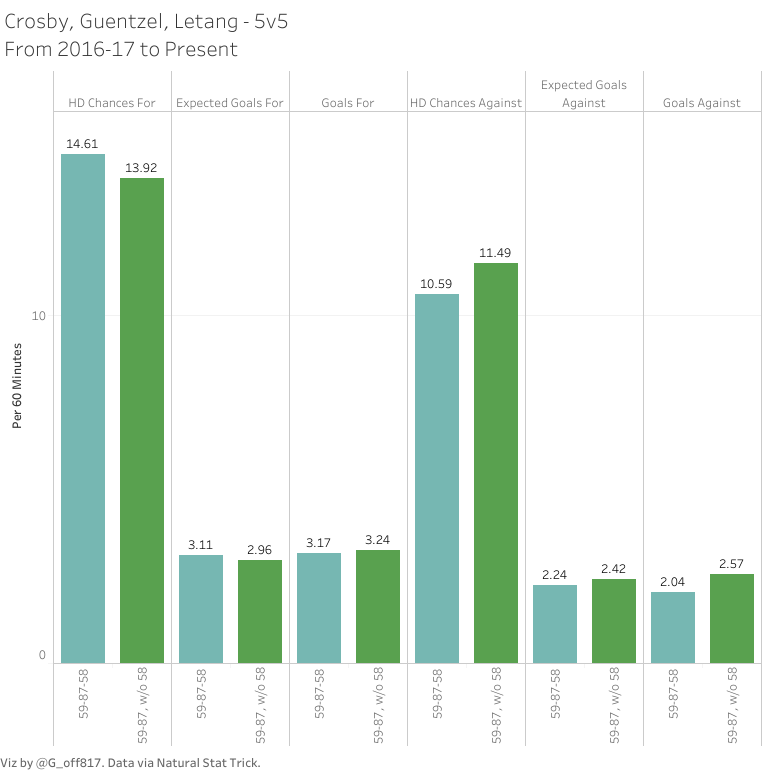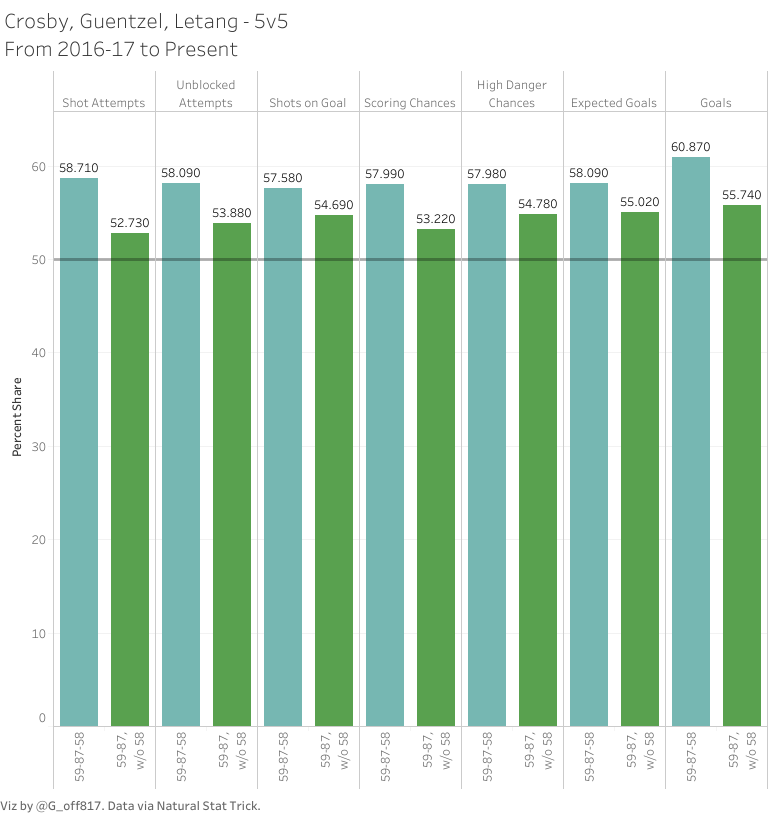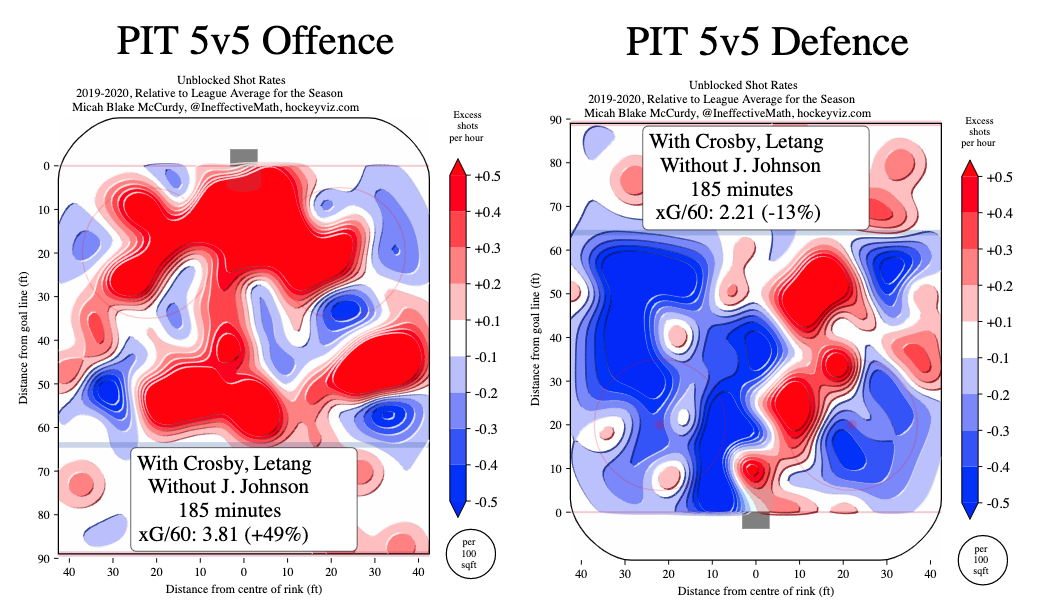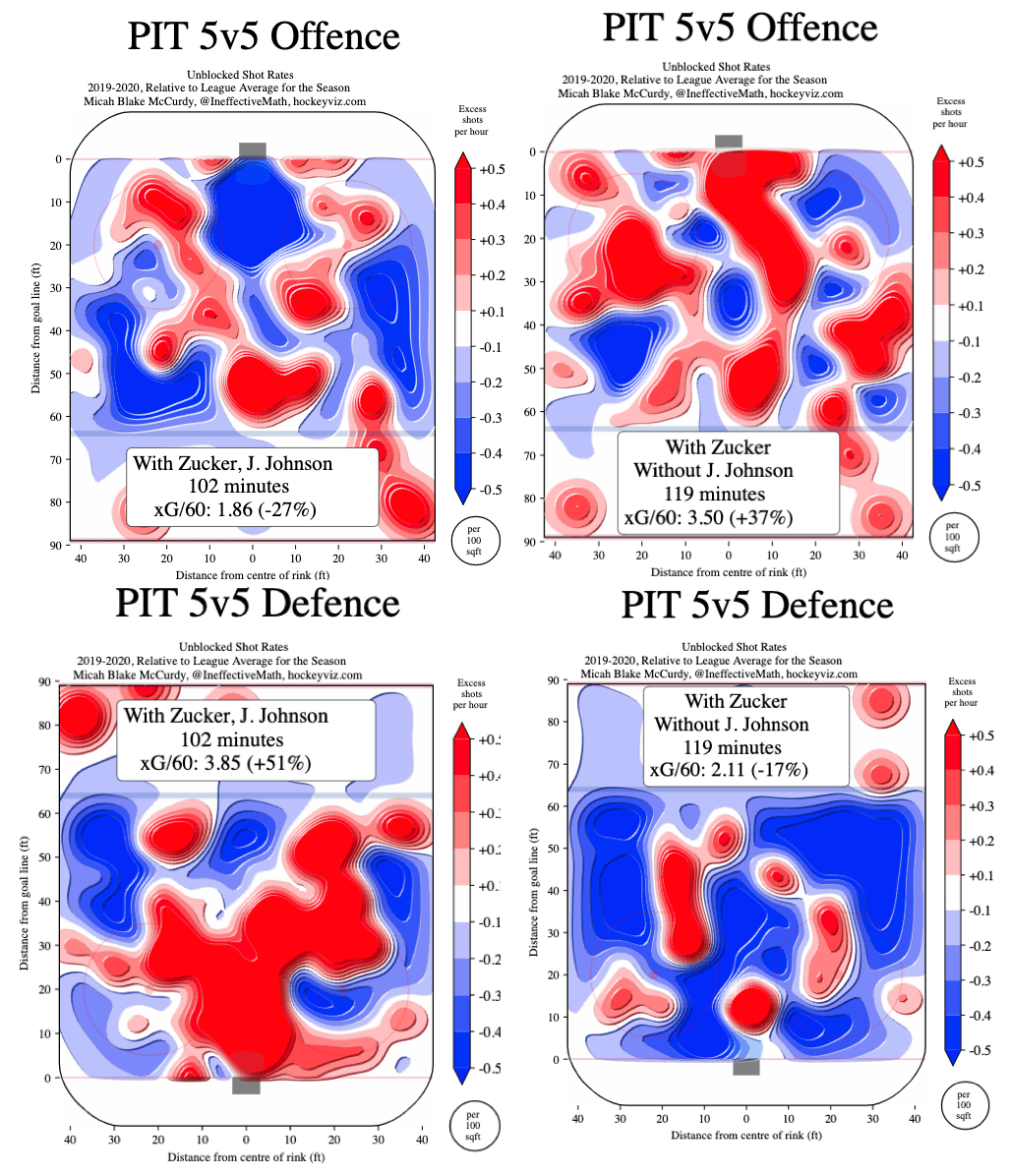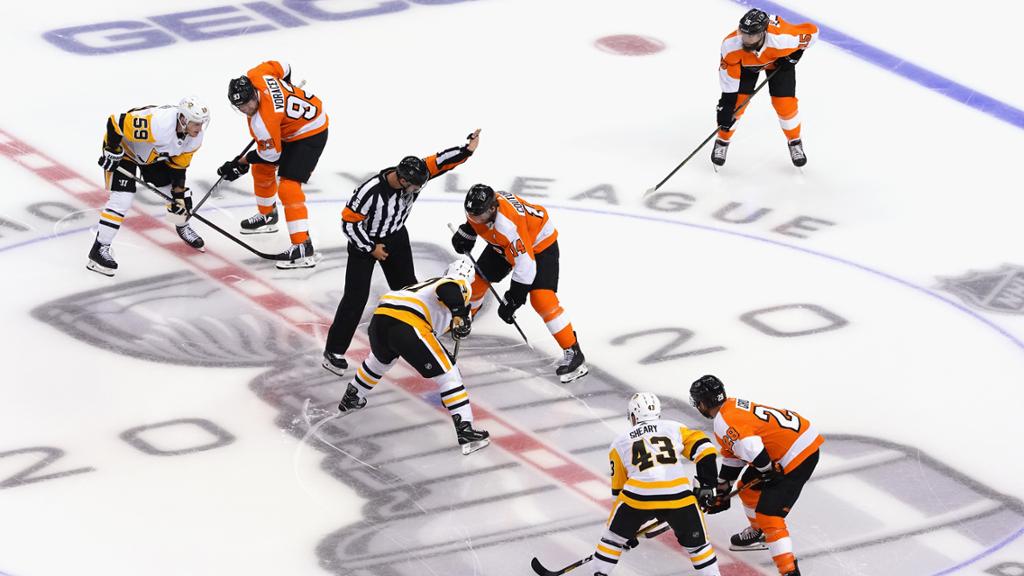
NHL hockey seems determined to return this Saturday in the midst of a global pandemic with some freakish tournament reminiscent of that time you tried to go on a vision quest in Montana.
By definition, Penguins hockey will also return in this weird format, with the Pens having to play the Montreal Canadiens in a best-of-five series to see who actually makes the playoffs.
It’s all very bizarre and strange and would only make sense in something like the American Horror Story universe, but based on the way 2020 has gone so far, we may actually be living in some alternate universe.
We can confirm these suspicions even further when we look at the Penguins forwards and, more specifically, the ones that won’t be taking part in this Return To Play situation.
Even more specifically, we’re talking about Dominik Simon and Nick Bjugstad, the former of which will be out of action for another couple of months after injuring his shoulder against the Sharks in February and the latter of which, whose season was decimated by injuries, may not be ready either following spinal surgery on a herniated disc.
Dominik Simon is recovering from successful shoulder surgery.
Simon suffered the injury on February 29 in a game against the Sharks.
He is expected to be sidelined for 6-7 months.
Full details: https://t.co/Ft2Lo5heP6 pic.twitter.com/mwTYJp3Bde
— Pittsburgh Penguins (@penguins) May 14, 2020
Yesterday, Nick Bjugstad underwent successful spinal surgery for a herniated disc.
The surgery was performed by Dr. Bradford Currier of the Mayo Clinic in Rochester, Minnesota.
The forward is expected to be sidelined for a minimum of eight weeks. pic.twitter.com/iStBmP0hHA
— Pittsburgh Penguins (@penguins) May 27, 2020
With those two out injured, it makes the outlook on the Penguins lines pretty straight forward, as evidenced by the first day of Training Camp 2.0:
Guentzel*-Crosby-Sheary
Zucker-Malkin-Rust
Marleau-McCann-Hornqvist
Tanev-Blueger-Aston-Reese
*Oh by the way, Jake Guentzel is back and healthy.
So what can we expect from this very deep, good looking crop of forwards?
Guentzel-Crosby-Sheary
Where to start with the Penguins top line? Crosby, limited to just 41 games this season after undergoing sports hernia surgery and being a limited participant in this modified training camp, is poised to return to the ice. Similarly, Jake Guentzel was limited to just 39 games this season when his reckless goal-scoring pace was cut short after an awkward crash into the boards injured his shoulder. Undeterred, GM Jim Rutherford went out and brought Conor Sheary back at the trade deadline, and, coupled with Dom Simon’s aforementioned season ending surgery.
All this is to say that we’ll see the reunification of the original 2017 Sid and the Kids Line.
But what exactly can we expect from a trio of players that hasn’t played together since the 2017-18 regular season?
For starters, there is a reasonable expectation that they will control the majority of the events that take place while they’re on the ice. In the 328:40 they played at 5-on-5 across 106 games from the 2016-17 season until present day, that’s exactly what they did.
Jake Guentzel has done nothing but improve (and score 60 goals in 121 games!) in the seasons since. Conor Sheary, despite playing on some pretty poor Sabres teams for the last two seasons, hasn’t seen a decline in his underlying on-ice metrics either. And Sidney Crosby, despite some defensive woes this season (more on that in a minute), is still Sidney Crosby.
Below, you’ll find two graphs representing what this line did from 2016-17 to present day as a line (106 games, 328+ minutes), without Sheary (218 games, 1989+ minutes), and without Guentzel (144 games, 974+ minutes) at 5-on-5.
The sample sizes are different, but the results are pretty similar. Over that two season stretch, Guentzel-Crosby-Sheary put up very similar attacking numbers as the duo of Guentzel-Crosby with their rotating cast of right wingers.
The difference was in the defensive zone, where Sid and the Kids failed to live up to what Crosby did with just one of them.
But, at a minimum, if they pick up where they left off at the end of the 2017-18 season, we should expect them to control right around 53% of the shot attempts, unblocked attempts, shots on goal, scoring chances, high danger chances, and expected goals even in spite of the trio seeing more events occur in their own end of the ice versus when it was just Crosby+Sheary or Crosby+Guentzel.
One way you’ll see the Penguins’ top line mitigate those events against them, and alternatively, increase their destruction of opponents in the offensive zone, will be simply seeing them play a substantial amount of time with the Dumoulin-Letang pairing.
While we don’t have more than a total of 71:33 minutes of 5v5 play where Letang played with those 3 due to injuries to 58, we do know that Letang is the straw that stirs the drink for the Penguins.
https://twitter.com/G_Off817/status/1285332910921351168
Additionally, we also know that Letang and Crosby are on the ice together a lot and the amount of success they have together can only be classified as also a lot. Via Natural Stat Trick, the only skater Crosby has seen more 5v5 ice time with than Letang (1583:40) is Jake Guentzel (2010:22). To that end, Crosby has seen more time with Letang than he’s spent away from him (1206:40). On top of that, since 2016-17 to present, Crosby and Guentzel have spent 1059:52 5v5 minutes across 172 games with Letang (versus 1258:39 without him). The difference is quite noticeable.
Across the board, in every single data bucket we have here (except for goals for, which is expected), the Penguins see more events take place inside the offensive zone when Crosby and Guentzel are sharing the ice together with Letang compared to when they’re not. Similarly, when Sid and Jake are without Letang, they are seeing more events take place in the defensive zone per 60 minutes of 5v5 play compared to when they’re playing with him.
The overall shares are shown below. It’s just not close.
Via HockeyViz.com, we can get a quick snapshot of the Penguins success this season with Crosby and Letang on the ice together this season as well.
[Note: Jack Johnson was removed from this for the sake of identifying Crosby and Letang alone, primarily because Johnson, who saw significant time as the top pairing left defenseman this season with Dumoulin out, will not be playing there come Saturday. The results with Johnson can be found here for the curious.]
[Note 2: Though 185 minutes isn’t a huge sample either, the results below are pretty close to 2017-18 (xGF/60: 3.36, +33%; xGA/60: 2.42, -4%) and 2018-19 (xGF/60: 3.41, +32%; xGA/60: 2.49, -4%) results for Crosby/Letang.]
A reminder that when looking at these maps, red indicates more shots compared to the league average, while blue reflects fewer. In other words, red in the offensive zone means the Penguins are generating more shots from those locations compared to the league average (good), while red in the defensive zone means they are allowing more shots than the league average from those locations (bad). Conversely, blue in the offensive zone is bad, while good in the defensive zone.
So with Crosby and Letang on the ice, independent of Crosby’s linemates, the Penguins absolutely hammer teams. Per 60 minutes of play, the Penguins generate 49% more expected goals (3.81) than that of the league average at 5-on-5. This is evident by the giant red blob around the net front and all through the low, middle, and high slot.
At the other end of the ice, they allowed just 2.21 expected goals per hour of 5v5 play, 13% less than the league average.
All this is to say that when Crosby’s line is on the ice with Letang, they are always going to be deadly. Mixing in a 100% healthy Jake Guentzel, undeniably the Penguins best goal scorer, and a player like Conor Sheary, who doesn’t negatively impact Crosby’s influence, and garnish that with a little Brian Dumoulin, at an absolute minimum, the Guentzel-Crosby-Sheary line is going to be a bulldozer around 50% of the time they hop over the boards at 5-on-5.
That should scare any team.
Zucker-Malkin-Rust
Perhaps the most fascinating line the Penguins will ice will be this second line of Zucker-Malkin-Rust.
We’ve long known the tandem of Malkin and Rust just works. While sharing the ice together this season, which has been 643:25 (and just 98:22 apart), they’ve outscored their opponents 46-30 and have controlled a 57.72% of the expected goals, 55.27% of the scoring chances, and 56.80% of the high danger chances.
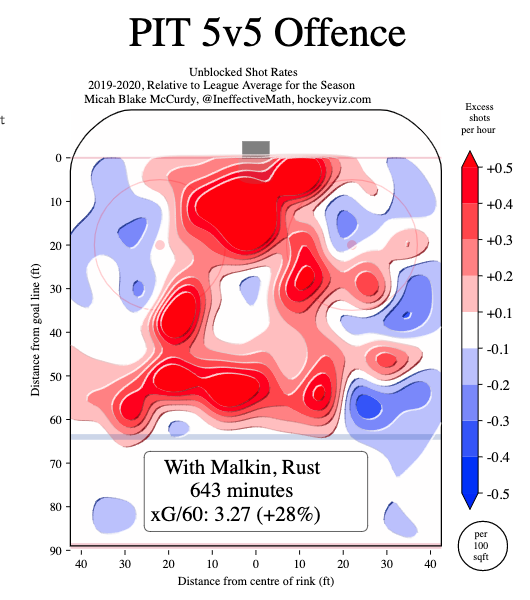
We also know that Jason Zucker hit the ground running with the Penguins following his summer February move from Minnesota, potting 6 goals and 6 assists (3G-5A at 5v5) in 15 games with the Pens. What’s more, the Penguins have controlled 54.04% of the shot attempts (53.23% when unblocked), though the scoring chance and expected goal data leaves a little to be desired, particularly on the defensive side of things.
Conventional wisdom will tell you that the drop off in defensive work can at least be partially attributed to playing 102+ of his total 221 5-on-5 minutes with the Penguins sharing the ice with Jack Johnson, similar to that of Crosby (it should also be noted that ~100 minutes of play isn’t a lot to go off of, but it’s all we have here in Zucker’s case). Utilizing HockeyViz.com’s Environment Distiller once again, we can take another quick snapshot of this:
In the case of Zucker during his short tenure so far with the Penguins, he has seen very few shots directed at the net in the offensive zone while sharing the ice with Johnson to the tune of an expected goal rate of 1.86, which is about 27% less goals per hour than the league average rate.
In the defensive zone, the results are even uglier. In their 102 shared minutes together, the Penguins hemorrhaged shots in excess of the league average from all of the high- and medium-danger areas, 51% more expected goals per hour compared to the league average.
On the other side of the coin, Zucker without Johnson looks much, much more like what Zucker has done historically throughout his career on an albeit dull Minnesota Wild team. Given that he has played 189:40 at 5v5 with Crosby and what we saw above, this all is expected.
Adding a player of his speed, skill, and quality to a tandem already rife with speed (Rust) and skill (Malkin) with the added benefit of seeing a lot of Marino and Pettersson on the backend, with whom Rust and Malkin saw an expected goals for per hour of 5v5 play of 3.47 across 180 minutes with Marino (+36% more than the league average) and 3.23 (+26% more than the league average) across 222 minutes with Pettersson (before those two became a pairing), it could be the Penguins second line that’s the true driving force for any potential deep run.
Marleau-McCann-Hornqvist
Sometimes, though, it doesn’t matter how good your first two lines are in the playoffs. Many times, it’s the 3rd line that wins series and championships (*cough HBK cough*).
And prior to injuries decimating the Penguins, they had themselves a 3rd line center that wasn’t just shutting teams down, but controlling the play in all 3 zones. In fact, his first 20+ games of the season were some of the best games the Penguins have seen out of their 3rd line centers in recent memory.
Varying roles thrust upon him as the season progressed and injuries piled up had an expected impact on that, but as the postseason opens up on Saturday, McCann will return to his spot centering the third line. He’ll be flanked by the Patric(k)s, one of whom McCann saw a decent chunk of time with this year.
| McCann+Hornqvist | Shot Attempts | Unblocked Attempts | Shots on Goal | Goals | Expected Goals | Scoring Chances | High Danger Chances |
| % Share | 47.72 | 49.15 | 50.00 | 53.33 | 56.04 | 57.14 | 50.75 |
One thing that stands out here is that, in nearly 250 minutes of 5-on-5 play, they gave up more shot attempts and unblocked attempts than they were generating. But they weren’t outscored and the quality they generated in terms of expected goals and both sets of scoring chances outnumbered what they allowed. Relative to the rest of the Penguins roster, these two generated less going forward than their teammates, which you might expect.
But it was defensively where they shined, relative to the Penguins and relative to the rest of the league.
| McCann+Hornqvist | Shot Attempts Against | Unblocked Attempts Against | Shots on Goal Against | Goals Against | Expected Goals Against | Scoring Chances Against | High Danger Chances Against |
| Per 60 minutes, Relative to Penguins | -4.41 | -4.65 | -4.55 | -1.11 | -0.73 | -5.95 | -2.39 |
Relative to the rest of the Penguins roster, when McCann and Hornqvist shared the ice together, the Penguins allowed less of every event compared to when they were off the ice. In other words, for example, the opposing team generated 5.95 fewer scoring per 60 minutes of 5-on-5 play against McCann and Hornqvist than when those two were off the ice.
Relative to the rest of the league, you could make the case that they were even more impressive, allowing just 1.78 expected goals against (31% less than that of the league average) and smothering anyone that even attempted to get to any area of the ice better than low danger.
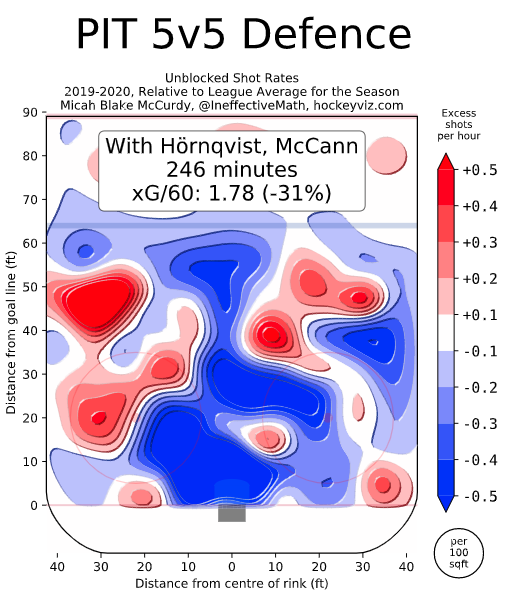
So while McCann may have felt a drop off in driving play forward after his impressive start, he and Hornqvist allowed very, very little against. In particular, they controlled the quality of opportunities.
When all is said and done, though, Patrick Marleau is likely going to be the ultimate x-factor on this line. Eight games and 90:31 5v5 minutes is hardly anything to go off of, particularly after coming over midseason. He managed a goal and an assist in those 90 minutes and his on-ice share of events were at least respectable (via Natural Stat Trick).
| Patrick Marleau | Shot Attempts | Unblocked Attempts | Shots on Goal | Goals | Expected Goals | Scoring Chances | High Danger Chances |
| % Share | 51.70 | 51.54 | 48.98 | 46.67 (outscored 8-7) | 46.81 | 53.57 | 48.57 |
One thing is for sure about Marleau: he still has wheels. They were really on display in the tune up game against the Flyers on Tuesday and, utilizing his and McCann’s speed, we could see this line be a brutal counter attacking threat.
You could really see them suffocate players in the D-zone as McCann and Hornqvist showed they will do, force turnovers before their opponents can call up Kenny Loggins and get a taste of the danger zone, and break up ice with enough speed to break the sound barrier.
Between these guys and the Pens 4th line, there may be enough there to cover the deficiencies of the 3rd D pairing.
Tanev-Blueger-Aston-Reese
If you’ve made it this far, congratulations. You’ve now gotten to the best 4th line in hockey.
Many teams will try to claim this crown, but it belongs to Brandon Tanev, Teddy Blueger, and our king, Zach Aston-Reese.
This is one hell of an own https://t.co/8GqhQ24YF7
— shellder keefe (@corncobdipshit) July 27, 2020
Before we get to the line as a whole, it doesn’t come without its own baggage. Tanev’s contract may yet still prove to be something we all come to rue, but right out of the gate this season, he was a beast. And while $3.5M for 6 years may be a lot for a 4th liner, the guy has more than proven his worth over the last calendar year.
And this line, too, has proven their worth. They’re their ultimate nuisance to play against. The combination of speed, tenacity, heavy forechecking, and overall puck hounding is what you think of these days in terms of “being hard to play against.”
This is just a snippet of what they do: playing with reckless abandon every single shift.
But let’s get into the data with these guys, the only line the Penguins will deploy starting on Saturday that has been together for any extended period of time this season (422:04 minutes of 5v5 play across 57 games).
| Tanev-Blueger-Aston-Reese | Shot Attempts | Unblocked Attempts | Shots on Goal | Goals | Expected Goals | Scoring Chances | High Danger Chances |
| % Share | 50.15 | 50.21 | 50.41 | 50.00 | 53.89 | 56.06 | 57.14 |
You might be saying to yourself, “Gee, how were they able to control over half of every event that took place on the ice when almost half (194 of 405) of their faceoffs took place in the defensive zone?”
It’s a valid question and has everything to do with being bastards to break down defensively. Much like McCann+Hornqvist, these guys don’t offer much as an offensive threat. They’ll chip in with the occasional goal, sure, but their bread and butter is blanketing their opposite in all 3 zones.
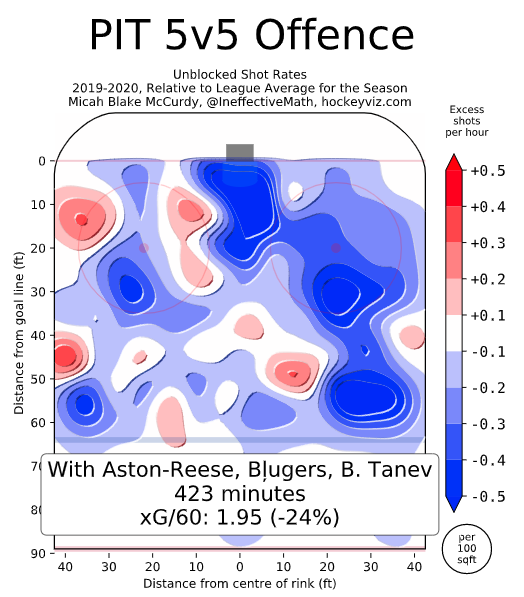
They may not get quality looks at your net (as evident above), but they’re going to pin you behind your own net until you either ice it, take a penalty (of which Tanev drew 14, joint second-most on the team and 1 behind Malkin’s team leading 15), or have to deal with Crosby or Malkin hopping over the boards to throttle you.
And if you just so happen to get out of your own zone or control the puck against them after an offensive zone faceoff, good luck. There won’t be much time or space for you to operate against them:
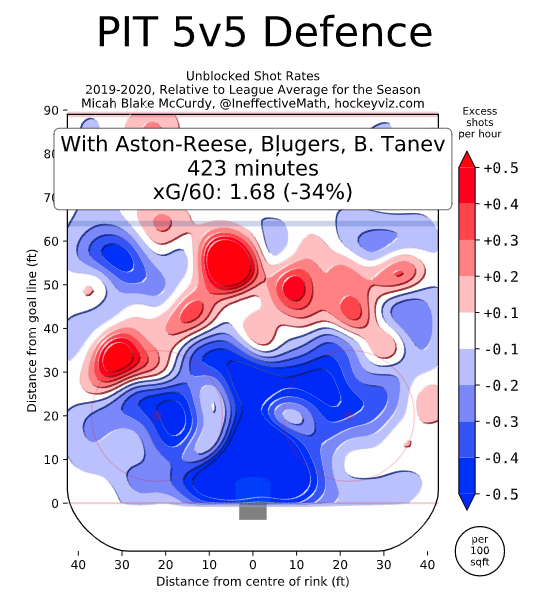
Relative to the rest of the league, from the goal line to the top of the circles in the Pens’ defensive zone is a black hole against this line.
And for as strong and powerful as McCann+Hornqvist were defensively relative to the rest of the Penguins, this 4th line was even more devastating in terms of suppressing their opposition.
| Tanev-Blueger-Aston-Reese | Shot Attempts Against | Unblocked Attempts Against | Shots on Goal Against | Goals Against | Expected Goals Against | Scoring Chances Against | High Danger Chances Against |
| Per 60 minutes, Relative to Penguins | -7.05 | -6.30 | -4.53 | -0.98 | -0.61 | -8.17 | -3.51 |
These guys are going to be nothing but a problem for anyone they’re matched up against and, folks, it is going to be fun.
But maybe the most important thing above all else is that the Penguins have balance and depth in their forward group. Of course, the expectation is going to be to get the goals through the top two lines, but none of these lines are anywhere close to being a liability defensively and, equally importantly, the bottom six has the ability to chip in offensively.
That’s what you need from a team that can and should make a deep run (even in a weird playoff format): balance and depth.
A little bit of luck doesn’t hurt either.
Up next, we’ll take a look at the 3 defensive pairings before getting into the Murray/Jarry discussion.
Add The Sports Daily to your Google News Feed!

